(Tank Road 火车总站,River Valley Road 背景, c.1903)
(Tank Road 火车总站, c.1910)
1932年FMSR以靠近海港(Keppel Harbour)的新落成的丹戎百葛火车站(Tanjong Pagar)取代穿梭于市区的登路火车总站,火车旅馆设在火车站内,就像怀旧影片中的情节一样。原建的从登路转换站到武吉知马的火车道在七年后拆除。
http://navalants.blogspot.com/2010/11/blog-post.html
至于大马境内的铁轨岁月则更悠久了:
1885: Taiping- Port Weld
1886: Kuala Lumpur - Klang
1891: Seremban - Port Dickson
1893:Teluk Anson - Tapah Road
1909:Prai (Penang state)- Johor Bahru
1931: Tumpat - Gemas
(马来亚小镇,c.1910)
丹戎巴葛火车站的正门有四尊大理石人物雕像,他们手握着不同的工具,代表着农业,商业,运输业和工业,这些行业都是早年马来亚的经济支柱。四尊大理石雕像性格鲜明,直接表达马来亚铁路的存在意义就是为了更好地运输工农业产品,为马来亚人民提供更多商业活动和就业机会。
http://nmsmandarindocents.wordpress.com/2010/09/27/丹戎巴葛ç«è½¦ç«™/
(Tanjong Pagar Railway Station, 2010)
2003年10月16日,外交部长贾古玛(Professor S Jayakumar)向国会解释丹戎巴葛总站乔迁事件:
The POA (Points of Agreement)is a Government-to-Government agreement between Malaysia and Singapore concerning railway lands in Singapore. It was signed on 27 November 1990 between then Prime Minister Lee Kuan Yew on behalf of Singapore and then Minister of Finance Tun Daim Zainuddin on behalf of Malaysia. Under the POA, the KTM railway station would be vacated and moved from Tanjong Pagar to Bukit Timah in the first instance. The land at Tanjong Pagar would then be vested in a limited company for joint development (60% for Malaysia and 40% for Singapore). All railway lands south of Bukit Timah other than Tanjong Pagar would revert to Singapore. When the MRT station reached Woodlands, and that took place on 10 February 1996, KTM may within five years, move its station from Bukit Timah to a site in Woodlands adjacent or close to the Woodlands MRT station. In that event, two additional pieces of land in Kranji and Woodlands would be vested in the limited company also for joint development. All other railway lands south of Woodlands other than Tanjong Pagar, Woodlands and Kranji sites would revert to Singapore. ....
后来新马双方就POA的实行日期与当时的马国首相马哈迪推翻新马谈判配套而陷入低谷。丹戎巴葛火车总站先迁移到Bukit Timah (Blackmore Drive) 和Woodlands 的计划并没有落实。其中个人成见似乎超过律法。
(Bukit Timah 火车站,c.1905)
(Bukit Timah 火车站,2011)
新领导人新作风,李显龙和纳吉的班子把历史包袱放在铁路旁,并同意若有无法协商之处,通过国际仲裁庭解决,避免伤了双方的和气。新马双方都为了2011年8月的乔迁之喜下足拼劲,势在必得。
1.1.11,我们延续2010年9月10日乘火车过长堤的心情,走一趟火车道(Railway Mall - Bukit Timah Railway Station),以另一类方式迎接新的一年。
(Railway Mall旁,2011)
(跨越Bukit Timah Road的铁桥)
(Bukit Timah Raliway Station的轨道转驳器,2011)
KTM铁路让我在十六岁青涩的一刻在社会染缸认识一群联邦工友,轰隆隆声中带来也送走了联邦同学。在Gombak Hill工作的时期,碰到火车时间,管理员关上闸门,车子停放在闸门前,形成一条车龙。火车走过,闸门重新开放,车子越过共用的铁轨,是铁路的风情画。
铁路穿过时空,铁路走过的Bukit Timah已从早年的工业区如以绿宝汽水挂帅的 Amoy Canning Factory都已发展成公寓,提供两万民宅给中上阶层,就只剩铁轨两旁还保留着盎盎绿意。
http://navalants.blogspot.com/2010/12/blog-post_31.html
(Upper Bukit Timah Road 的绿宝汽水厂,c.1960s)
绿草悠悠,铁轨没有尽头,望着远方朦胧处,油然忆起2000年代初的爱情电影,巩俐、梁家辉、孙红雷等主演的《周渔的火车》。电影的开头,就是这么一道铁路弯弯。
(Bukit Timah Hill 旁,2011)
一列火车上,满是人,很多为生计或者为别的什么奔忙的人。其中,有一个女人叫周渔。她的奔忙先是为了一个男人,然后是两个,最后,是为了她自己。这便是《周渔的火车》要讲述的爱情故事。
周渔的爱情就在那列车上,承载着她的矛盾、欲望和对爱的幻想。经过大大小小的车站,卸下一些,又装上一些,但她始终是运动着的,充满活力,火车是周渔成长的地方。
周渔在小镇上从事陶艺工作,在一个舞会上遇上诗人陈清后,对他的眷恋油然而生。陈清在另一镇上做图书管理员,生活清贫,爱情的力量让周渔甘心劳苦,来往于两地。慢慢的,她变得有点疲倦。
火车上周渔遇见兽医张强,张强为周渔的气质所打动,二人由起初的争拗变为理解。张强总是在周渔失落烦恼之时为她解忧,帮她找寻陈清诗中所写的仙湖,感情在暗涌。周渔也在两地、两个男人之间矛盾地徘徊。在张强身上,她感受到强烈的男子气魄和欲望,然而却也离不开孱弱的陈清。
周漁身边的人,甚至陈清,都说她这样赶火车太累也太傻,她总说不觉得累,她很喜欢穿梭两地的感觉。可是时间久了,她动摇了。
陈清离开小镇,到西藏去当小学老师,周漁还是继续赶火车到初恋的小镇,去陈清搬离的破屋,回忆他们的过往。
最后一次周漁沒有赶上火车,改搭汽车,在路上出了意外,汽车翻入河里淹死了。
不知道周渔的火车的终点在哪里,只能跟随她,跟随那列火车。也许我们永远不能真正体会她,但却真实地看到了她的成长,令人感动。
周渔的火车是否出现过?仙湖是梦境还是真实? 火车是不是让心灵歇息的地方?周渔是否得到最后的解脱?
突然间发觉我们每个人的心中有意识无意识间都跟随着某一趟列车,轧轧前进,有如周渔的火车。心里有就有,心里是就是。心里没有才真的没有,全都一场空了。

























